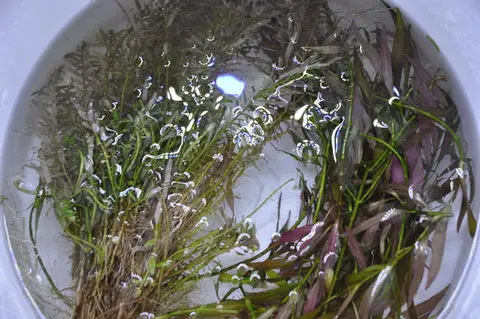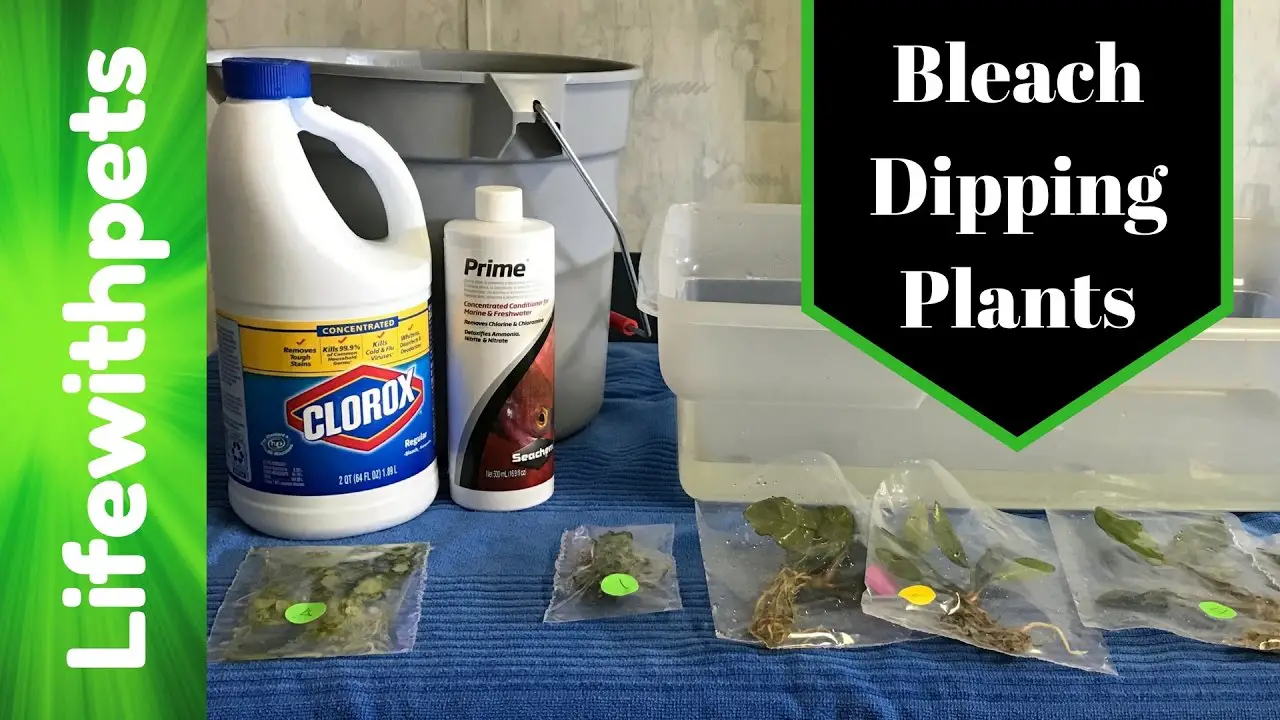Do you struggle with keeping your aquarium plants clean and healthy? Are you tired of dealing with algae growth, pests, and diseases? If so, you may want to consider using a bleach dip for your aquarium plants. A bleach dip is a simple and effective way to sanitize your plants and prevent the spread of harmful organisms.
But, when should you use a bleach dip and how do you do it safely? In this article, we’ll explore the benefits and risks of using a bleach dip for aquarium plants, and provide you with step-by-step instructions on how to use this method safely and effectively. Whether you’re a seasoned aquarium hobbyist or a beginner, this guide will help you keep your plants healthy and thriving.
A bleach dip is a common method of sterilizing aquarium plants before adding them to a new tank. To do a bleach dip, mix a 19 parts water to 1 part bleach solution and soak the plants for 2-3 minutes. Rinse thoroughly with water before adding them to the tank. Only use this method on hardy plants as it can damage or kill delicate ones. Bleach dips should be done as a last resort if other methods, such as quarantine and cleaning, have failed.

When and How to Use a Bleach Dip for Aquarium Plants?
Aquarium plants require regular maintenance to ensure their healthy growth and to prevent diseases from spreading. One effective method of cleaning aquarium plants is a bleach dip. This technique involves soaking plants in a diluted bleach solution for a short period. Here’s what you need to know about using a bleach dip for your aquarium plants.
What is a bleach dip?
A bleach dip is a technique used to disinfect aquarium plants. It involves soaking plants in a diluted bleach solution for a short period. The bleach solution kills bacteria, fungi, and parasites that may be present on the plant’s surface. Bleach dips are particularly useful for new plants or those that have been exposed to diseases.
To make a bleach solution, mix one part bleach with nineteen parts water. Ensure that the bleach is unscented and does not contain any additives. The solution should be prepared in a well-ventilated area, and you should wear gloves to protect your skin.
When should you use a bleach dip?
You should use a bleach dip when you want to disinfect new plants before adding them to your aquarium. You should also use a bleach dip if you suspect that your existing plants are infected with diseases. Signs of disease include yellowing leaves, stunted growth, and spots on the leaves.
To prevent the spread of disease, it’s best to isolate infected plants and treat them separately. A bleach dip is an effective way to disinfect the plants before returning them to the main aquarium.
How to perform a bleach dip?
To perform a bleach dip, follow these steps:
1. Prepare the bleach solution as described above.
2. Remove the plants from the aquarium and rinse them under running water to remove any debris.
3. Place the plants in a clean container and cover them with the bleach solution. Ensure that the plants are completely submerged.
4. Leave the plants in the bleach solution for 2-3 minutes. Do not leave them for longer as this can damage the plants.
5. Remove the plants from the bleach solution and rinse them thoroughly under running water.
6. Soak the plants in a dechlorinated water solution for about 15 minutes to remove any remaining bleach residue.
7. Rinse the plants again and return them to the aquarium.
Benefits of using a bleach dip
Using a bleach dip has several benefits:
1. It is an effective way to disinfect new plants before adding them to your aquarium.
2. It prevents the spread of diseases in your aquarium.
3. It can revive struggling plants by removing harmful bacteria and parasites.
4. It is a cost-effective method of cleaning your aquarium plants.
Precautions when using a bleach dip
When using a bleach dip, it’s important to take precautions to avoid damaging your plants:
1. Do not use bleach dips on delicate or fragile plants as they may be damaged.
2. Do not leave plants in the bleach solution for longer than 3 minutes as this can damage them.
3. Rinse the plants thoroughly after the bleach dip to remove any remaining bleach residue.
4. Use gloves to protect your skin when preparing the bleach solution and handling the plants.
5. Ensure that the bleach is unscented and does not contain any additives.
Bleach dip vs other cleaning methods
There are other methods of cleaning aquarium plants, such as hydrogen peroxide dips and potassium permanganate dips. However, bleach dips are considered to be the most effective for disinfecting plants. Bleach is readily available, inexpensive, and kills a wide range of bacteria, fungi, and parasites.
In conclusion, a bleach dip is an effective way to disinfect your aquarium plants. It is particularly useful for new plants or those that have been exposed to diseases. By following the precautions and guidelines outlined above, you can ensure that your plants remain healthy and disease-free.
Frequently Asked Questions
In this section, we will answer some of the most common questions about when and how to use a bleach dip for aquarium plants.
Q: What is a bleach dip, and when should I use it on my aquarium plants?
A bleach dip is a solution of water and bleach that is used to disinfect aquarium plants. It is recommended to use a bleach dip when introducing new plants to your aquarium or if your plants are showing signs of disease or pests. A bleach dip can also be used as a preventative measure to help ensure the health of your plants.
It is important to note that not all plants can tolerate a bleach dip, so be sure to research the specific plants in your aquarium before using this method.
Q: How do I make a bleach dip for my aquarium plants?
To make a bleach dip, you will need a container large enough to submerge your plants and a solution of water and bleach. The recommended ratio is 19 parts water to 1 part bleach. For example, if you have 1 gallon of water, you would add approximately 3 tablespoons of bleach.
Submerge your plants in the solution for 2-3 minutes, making sure to agitate the water to ensure that the solution reaches all parts of the plant. After the 2-3 minutes, remove the plants and rinse them several times in clean water before returning them to the aquarium.
Q: Can I use a bleach dip on all types of aquarium plants?
No, not all plants can tolerate a bleach dip. Some plants, such as Anubias and Java fern, are sensitive to bleach and can be damaged or killed by the solution. Before using a bleach dip, research the specific plants in your aquarium to ensure they can tolerate this method of disinfection.
Additionally, be sure to use the recommended ratio of water to bleach and to only submerge the plants for the recommended amount of time to avoid damaging your plants.
Q: Do I need to quarantine my plants after a bleach dip?
Yes, it is recommended to quarantine your plants for a period of time after a bleach dip to ensure that any remaining pests or diseases are eliminated. Quarantine your plants in a separate tank or container for at least a week before reintroducing them to your main aquarium.
During the quarantine period, monitor your plants closely for any signs of disease or pests and treat them as necessary before returning them to your main aquarium.
Q: Are there any alternatives to using a bleach dip for disinfecting my aquarium plants?
Yes, there are alternative methods for disinfecting your aquarium plants, such as using hydrogen peroxide or potassium permanganate. These methods can be less harsh on your plants than a bleach dip, but they also require careful research and proper usage to avoid damaging your plants or harming your fish.
Before using any method of disinfecting your plants, be sure to research the specific plants in your aquarium and consult with a knowledgeable aquarium expert to ensure you are using the best method for your specific situation.

How to Bleach Dip Aquarium Plants
In conclusion, using a bleach dip for aquarium plants can be a useful tool for controlling and preventing the spread of disease and pests in your tank. However, it is important to use the bleach dip correctly and at the appropriate times to avoid harming your plants.
First and foremost, always research and follow the proper instructions for preparing and using a bleach dip. Improper use can lead to damaged or even dead plants, and can also harm the other inhabitants of your tank. It is important to be patient and take the time to properly sanitize your plants to ensure their health and the health of your overall aquarium ecosystem.
Additionally, a bleach dip should only be used in certain situations. If you notice signs of disease or pests on your plants, or have recently acquired new plants that may be carrying pathogens, a bleach dip can be a helpful tool. However, it should not be used as a routine maintenance practice.
Overall, using a bleach dip for aquarium plants can be an effective and important step in maintaining a healthy and thriving aquarium. By following proper procedures and only using it when necessary, you can help to ensure the ongoing health and success of your tank.
